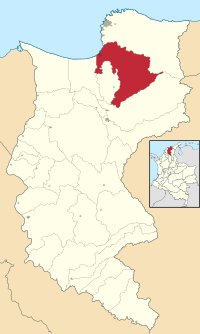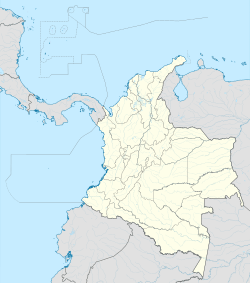Ciénaga, Magdalena facts for kids
Quick facts for kids
Ciénaga
|
|||
|---|---|---|---|
|
municipality
|
|||

Central Park in the town of Ciénaga
|
|||
|
|||

Location of the municipality and town of Cienaga in the Department of Magdalena
|
|||
| Country | Colombia | ||
| Region | Caribbean | ||
| Department | Magdalena | ||
| Foundation | 1521 | ||
| Incorporated | 1817 | ||
| Area | |||
| • municipality | 1,325 km2 (512 sq mi) | ||
| • Urban | 9.86 km2 (3.81 sq mi) | ||
| Elevation | 10 m (30 ft) | ||
| Population
(2020 est.)
|
|||
| • municipality | 124,339 | ||
| • Density | 93.84/km2 (243.05/sq mi) | ||
| • Urban | 110,303 | ||
| • Urban density | 11,187/km2 (28,974/sq mi) | ||
| Demonym(s) | Cienaguero,-a | ||
| Time zone | UTC-5 | ||
| Area code(s) | 57 + 3 | ||
| Website | Official website: https://web.archive.org/web/20130809111406/http://cienaga-magdalena.gov.co/ | ||
Ciénaga is a city and municipality in the Magdalena Department of Colombia. It is the second largest city in this department, right after Santa Marta. Ciénaga is located in northern Colombia. It sits between the Sierra Nevada de Santa Marta mountains, the Caribbean Sea, and a large marsh called the Ciénaga Grande de Santa Marta. The city is about 35 kilometers (22 miles) from Santa Marta. In 2020, about 110,303 people lived there. The average yearly temperature is around 34°C (93°F).
Contents
History of Ciénaga
Before the Spanish arrived, the area was home to many Chimila indigenous people. They had a village called Pongueyca. The exact founding date of Ciénaga is not fully clear. This is because there are different historical ideas and not many old documents.
Early Settlements and Names
People believe the first settlement was in a small village now known as Pueblo Viejo. This was once a Chimila tribal area. In 1529, a monk named Fray Tomás Ortiz started a church there. This church later burned down. The city was then re-established by Fernando de Mier y Guerra. He named it Villa de San Juan Bautista de la Ciénaga. However, it was also known by other names. These included San Juan del Córdoba, Aldea Grande, Córdoba, Pueblo de la Ciénaga, and simply Ciénaga.
Battles and Important Events
On November 10, 1820, Ciénaga became a battlefield. This happened during the Venezuelan War of Independence from Spain. The fight was between people loyal to Spain and those who wanted independence. This event is known as the Battle of Ciénaga.
Later, on December 6, 1928, a sad event happened in the town. It is known as the Banana Massacre. This occurred during a strike by workers for the United Fruit Company. Many workers died after the government sent military forces to stop the strike.
Becoming a Heritage Town
In 2012, the Colombian government gave Ciénaga a special title. It was named a Pueblo Patrimonio, which means "heritage town." This made it the first town in the Magdalena department to receive this honor. As of March 2021, Ciénaga is the northernmost heritage town in Colombia.
Culture and Traditions
Ciénaga is famous for being the birthplace or home of many talented people.
Notable People and Music
- Colonel Clemente Escalona: He was a hero from the Thousand Days' War. He was also a musician and farmer. He was the father and teacher of vallenato composer Rafael Escalona.
- Guillermo Buitrago: He was a very important figure in 20th-century folklore in Colombia. He died very young, at 29 years old. The city holds an annual festival to honor him. It is called the Guillermo de Jesús Buitrago Guitar Festival.
- Andrés Paz Barrosthe: He was born in Ciénaga. He was a founder of cumbia cienaguera music and a musical composer.
Local Celebrations
Every year on January 20, Ciénaga celebrates the Fiesta del Caimán. This means "Feast of the Caiman (alligator-like reptile)." It honors a local legend called La Historia de Tomasita.
Ciénaga in Literature
The famous writer Gabriel García Márquez wrote about Ciénaga. He mentioned the impact of the banana industry on the town in his books. You can read about it in 100 Years of Solitude and The Leaf Storm.
Historical Port City
It is important to know that Ciénaga was a main port in Colombia in the late 1800s. Many immigrant groups came to Colombia through this port. Most of them came from Lebanon and Europe.
Climate
Ciénaga has a warm climate. Here is some information about the weather:
| Climate data for Ciénaga (Ye La), elevation 20 m (66 ft), (1981–2010) | |||||||||||||
|---|---|---|---|---|---|---|---|---|---|---|---|---|---|
| Month | Jan | Feb | Mar | Apr | May | Jun | Jul | Aug | Sep | Oct | Nov | Dec | Year |
| Mean daily maximum °C (°F) | 33.1 (91.6) |
33.5 (92.3) |
33.7 (92.7) |
33.9 (93.0) |
33.3 (91.9) |
33.3 (91.9) |
33.3 (91.9) |
33.1 (91.6) |
32.7 (90.9) |
32.3 (90.1) |
32.3 (90.1) |
32.6 (90.7) |
33.1 (91.6) |
| Daily mean °C (°F) | 28.4 (83.1) |
28.9 (84.0) |
29.2 (84.6) |
29.5 (85.1) |
29.1 (84.4) |
29.0 (84.2) |
28.9 (84.0) |
28.5 (83.3) |
28.1 (82.6) |
27.7 (81.9) |
27.9 (82.2) |
27.9 (82.2) |
28.6 (83.5) |
| Mean daily minimum °C (°F) | 20.7 (69.3) |
21.5 (70.7) |
22.5 (72.5) |
23.2 (73.8) |
23.1 (73.6) |
22.9 (73.2) |
22.3 (72.1) |
22.2 (72.0) |
22.2 (72.0) |
21.8 (71.2) |
21.5 (70.7) |
20.7 (69.3) |
22.1 (71.8) |
| Average precipitation mm (inches) | 0.9 (0.04) |
1.0 (0.04) |
3.5 (0.14) |
30.1 (1.19) |
75.6 (2.98) |
88.5 (3.48) |
51.1 (2.01) |
90.0 (3.54) |
128.2 (5.05) |
149.7 (5.89) |
61.1 (2.41) |
26.5 (1.04) |
702.3 (27.65) |
| Average precipitation days | 0 | 0 | 0 | 3 | 8 | 10 | 10 | 13 | 14 | 14 | 7 | 2 | 80 |
| Average relative humidity (%) | 71 | 69 | 70 | 72 | 75 | 75 | 75 | 77 | 78 | 79 | 78 | 76 | 75 |
| Mean monthly sunshine hours | 275.9 | 245.6 | 238.7 | 213.0 | 201.5 | 204.0 | 207.7 | 210.8 | 183.0 | 198.4 | 216.0 | 254.2 | 2,648.8 |
| Mean daily sunshine hours | 8.9 | 8.7 | 7.7 | 7.1 | 6.5 | 6.8 | 6.7 | 6.8 | 6.1 | 6.4 | 7.2 | 8.2 | 7.3 |
| Source: Instituto de Hidrologia Meteorologia y Estudios Ambientales | |||||||||||||
Images for kids
See also
 In Spanish: Ciénaga (Magdalena) para niños
In Spanish: Ciénaga (Magdalena) para niños










